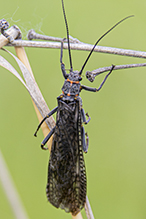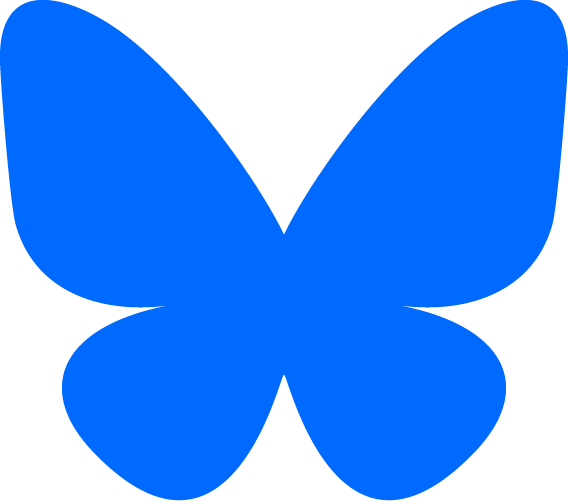Minnesota Stoneflies

Order Plecoptera
Plecoptera is the order of insects known as stoneflies. They have a soft, elongated, flattened body; three pairs of robust legs; two pairs of membranous wings; and a pair of sensory appendages (cerci) at the end of the abdomen. They have two large compound eyes, two or three simple eyes (ocelli), and long antennae with multiple segments. The mouthparts of most species are vestigial, and these adults do not feed at all. Some species have simple mouthparts with chewing mandibles. There is a pair of claws at the end of each leg. The hindwings fold flat over the body and cover most of the abdomen. The forewings are narrower than the hindwings. Stoneflies are poor fliers and will usually run rather than fly when disturbed.
Nymphs spend two or three years in well aerated water. Adults live only two of three weeks. They are usually found among stones in or near streams, which explains the common name “stoneflies”. They are highly intolerant of water pollution, and their presence is considered an indicator of a quality stream.
Plecoptera is a small order. There are 18 families, about 300 genera, and about 3,500 described species worldwide. There are about 670 species in North America north of Mexico.
Recent Additions

Midwestern salmonfly (Pteronarcys pictetii) is a large, dark brown, giant stonefly. It is common in the Midwest from Minnesota and Wisconsin south to Kansas and Indiana. Adults are 1½″ to 2½″ long. The head narrows slightly in the rear and has a thin, bright orange, rear margin. The plate covering the thorax is highly sculptured and has a thin, bright orange stripe in the middle and three bright orange spots at the base. The legs are robust. The wings have many prominent veins.
Young (nymphs) live in well aerated water of small and medium-sized streams. They eat particulate plant matter in the water and move very slowly. When disturbed they will pretend to be dead. They take 2 to 3 years to develop. Adults emerge from April to June and live for only 2 to 3 weeks. They are poor fliers and when disturbed they will run rather than fly away. They are sometimes found far from water. They are active at night (nocturnal) and are attracted to lights.
Other Recent Additions

This list includes only stoneflies that have been recorded in Minnesota, but not all of the stoneflies found in Minnesota.
| Profile | Photo | Video | |||
|---|---|---|---|---|---|
American salmonfly (Pteronarcys dorsata) |
|
||||
angulate snowfly (Paracapnia angulata) |
|||||
Atlantic sallfly (Alloperla atlantica) |
|||||
boreal snowfly (Allocapnia minima) |
|||||
boreal stone (Acroneuria lycorias) |
|||||
boreal stripetail (Isoperla transmarina) |
|||||
boreal willowfly (Taeniopteryx nivalis) |
|||||
broad-lobed needlefly (Leuctra tenella) |
|||||
Canadian willowfly (Oemopteryx glacialis) |
|||||
central forestfly (Prostoia completa) |
|||||
coastal stone (Neoperla clymene) |
|||||
colorful stripetail (Isoperla slossonae) |
|||||
colorless stripetail (Isoperla orata) |
|||||
common snowfly (Allocapnia granulata) |
|||||
common stone (Acroneuria abnormis) |
|||||
crescent stripetail (Isoperla emarginata) |
|||||
dark stripetail (Isoperla lata) |
|||||
eastern forestfly (Amphinemura delosa) |
|||||
eastern needlefly (Leuctra ferruginea) |
|||||
eastern willowfly (Taeniopteryx burksi) |
|||||
embossed stone (Paragnetina media) |
|||||
giant stone (Attaneuria ruralis) |
|||||
hooked willowfly (Taeniopteryx parvula) |
|||||
Hudsonian springfly (Isogenoides frontalis) |
|||||
Illinois snowfly (Allocapnia illinoensis) |
|||||
Indiana springfly (Isogenoides doratus) |
|||||
intrepid forestfly (Shipsa rotunda) |
|||||
least sallfly (Haploperla brevis) |
|||||
lobed stone (Acroneuria internata) |
|||||
longhorn forestfly (Prostoia similis) |
|||||
lovely forestfly (Amphinemura linda) |
|||||
Manitoba snowfly (Capnura manitoba) |
|||||
maritime forestfly (Podmosta macdunnoughi) |
|||||
Michigan springfly (Isogenoides krumholzi) |
|||||
midwest snowfly (Allocapnia rickeri) |
|||||
midwestern stone (Agnetina flavescens) |
|||||
midwestern stripetail (Isoperla marlynia) |
|||||
Minnesota stripetail (Isoperla maxana) |
|||||
montane stripetail (Isoperla montana) |
|||||
mottled willowfly (Strophopteryx fasciata) |
|||||
multispine stone (Neoperla stewarti) |
|||||
narrow-lobed needlefly (Leuctra tenuis) |
|||||
northern stone (Agnetina capitata) |
|||||
olive springfly (Isogenoides olivaceus) |
|||||
plains stripetail (Isoperla longiseta) |
|||||
pygmy snowfly (Allocapnia pygmaea) |
|||||
quadrate sallfly (Haploperla orpha) |
|||||
Rock Island springfly (Isogenoides varians) |
|||||
sable stripetail (Isoperla dicala) |
|||||
shortwing snowfly (Allocapnia vivipara) |
|||||
spinyleg willowfly (Taeniopteryx maura) |
|||||
sterling stripetail (Isoperla richardsoni) |
|||||
striped stone (Perlinella drymo) |
|||||
three-spined forestfly (Nemoura trispinosa) |
|||||
transverse stripetail (Isoperla signata) |
|||||
truncate sallfly (Alloperla leonarda) |
|||||
two-lined stripetail (Isoperla bilineata) |
|||||
vernal snowfly (Capnia vernalis) |
|||||
vernal stone (Perlinella ephyre) |
|||||
Wisconsin stripetail (Isoperla frisoni) |
Acroneuria abnormis (common stone)
Acroneuria internata (lobed stone)
Acroneuria lycorias (boreal stone)
Agnetina capitata (northern stone)
Agnetina flavescens (midwestern stone)
Allocapnia granulata (common snowfly)
Allocapnia illinoensis (Illinois snowfly)
Allocapnia minima (boreal snowfly)
Allocapnia pygmaea (pygmy snowfly)
Allocapnia rickeri (midwest snowfly)
Allocapnia vivipara (shortwing snowfly)
Alloperla atlantica (Atlantic sallfly)
Alloperla leonarda (truncate sallfly)
Amphinemura delosa (eastern forestfly)
Amphinemura linda (lovely forestfly)
Attaneuria ruralis (giant stone)
Capnia vernalis (vernal snowfly)
Capnura manitoba (Manitoba snowfly)
Haploperla brevis (least sallfly)
Haploperla orpha (quadrate sallfly)
Isogenoides doratus (Indiana springfly)
Isogenoides frontalis (Hudsonian springfly)
Isogenoides krumholzi (Michigan springfly)
Isogenoides olivaceus (olive springfly)
Isogenoides varians (Rock Island springfly)
Isoperla bilineata (two-lined stripetail)
Isoperla dicala (sable stripetail)
Isoperla emarginata (crescent stripetail)
Isoperla frisoni (Wisconsin stripetail)
Isoperla lata (dark stripetail)
Isoperla longiseta (plains stripetail)
Isoperla marlynia (midwestern stripetail)
Isoperla maxana (Minnesota stripetail)
Isoperla montana (montane stripetail)
Isoperla orata (colorless stripetail)
Isoperla richardsoni (sterling stripetail)
Isoperla signata (transverse stripetail)
Isoperla slossonae (colorful stripetail)
Isoperla transmarina (boreal stripetail)
Leuctra ferruginea (eastern needlefly)
Leuctra tenella (broad-lobed needlefly)
Leuctra tenuis (narrow-lobed needlefly)
Nemoura trispinosa (three-spined forestfly)
Neoperla clymene (coastal stone)
Neoperla stewarti (multispine stone)
Oemopteryx glacialis (Canadian willowfly)
Paracapnia angulata (angulate snowfly)
Paragnetina media (embossed stone)
Perlinella drymo (striped stone)
Perlinella ephyre (vernal stone)
Podmosta macdunnoughi (maritime forestfly)
Prostoia completa (central forestfly)
Prostoia similis (longhorn forestfly)
Pteronarcys dorsata (American salmonfly)
Pteronarcys pictetii (midwestern salmonfly)
Pteronarcys spp. (giant stoneflies and salmonflies)
Shipsa rotunda (intrepid forestfly)
Strophopteryx fasciata (mottled willowfly)
Taeniopteryx burksi (eastern willowfly)
Taeniopteryx maura (spinyleg willowfly)
Taeniopteryx nivalis (boreal willowfly)
Taeniopteryx parvula (hooked willowfly)
No Species Page Yet?
If you do not see a linked page for a species in the list at left you can still upload a photo or video or report a sighting for that species. Click on one of the buttons below and type in the common name and/or scientific name of the species in your photo, video, or sighting. A new page will be created for that species featuring your contribution.
These buttons not working for you?
Simply email us at info@MinnesotaSeasons.com.






